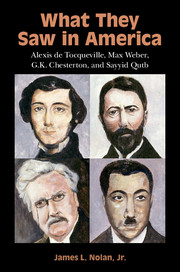Book contents
- Frontmatter
- Dedication
- Contents
- Acknowledgments
- Introduction
- 1 Pride, Patriotism, and the Mercantilist Spirit: Tocqueville and Beaumont Discover America
- 2 Tocqueville and the Quandary of American Democracy
- 3 Agrarianism, Race, and the End of Romanticism: Weber in Early Twentieth-Century America
- 4 Weber on Sects, Schools, and the Spirit of Capitalism
- 5 A New Martin Chuzzlewit: Chesterton on Main Street
- 6 Chestertonian Distributism and the Democratic Ideal
- 7 From Musha to New York: Qutb Encounters American Jahiliyya
- 8 Qutb's “Inquiring Eyes” in Colorado and California
- Conclusion
- Notes
- References
- Index
5 - A New Martin Chuzzlewit: Chesterton on Main Street
Published online by Cambridge University Press: 05 April 2016
- Frontmatter
- Dedication
- Contents
- Acknowledgments
- Introduction
- 1 Pride, Patriotism, and the Mercantilist Spirit: Tocqueville and Beaumont Discover America
- 2 Tocqueville and the Quandary of American Democracy
- 3 Agrarianism, Race, and the End of Romanticism: Weber in Early Twentieth-Century America
- 4 Weber on Sects, Schools, and the Spirit of Capitalism
- 5 A New Martin Chuzzlewit: Chesterton on Main Street
- 6 Chestertonian Distributism and the Democratic Ideal
- 7 From Musha to New York: Qutb Encounters American Jahiliyya
- 8 Qutb's “Inquiring Eyes” in Colorado and California
- Conclusion
- Notes
- References
- Index
Summary
Just over seventeen years after Weber returned to Germany, G. K. Chesterton and his wife, Frances, boarded the Kaiserin Auguste Victoria in Liverpool, England en route to New York. This would be the first of two trips Chesterton would make to the United States. He and Frances spent three months in North America in 1921 and then a little more than six months in 1930–1931, when Chesterton's secretary, Dorothy Collins, also joined them. Chesterton did not originally intend to write about his time in the United States; he announced just before leaving England in 1921 that, unlike a number of previous British literary visitors, he would not write a book about America. Fortunately, at least for the purposes of the present study, it is a promise that he would not keep, as he published two books on America, one after each visit: What I Saw in America (1922) and Sidelights on New London and Newer York (1932), the latter of which includes thoughts on the processes of Americanization. Reflections offered in these works suggest that his earlier unfulfilled announcement was in part a reaction against the “sneering” critiques offered by such previous British visitors as Charles Dickens and Frances Trollope, whose analyses he viewed as too smug, superficial, and snobbish. Indeed, one senses that he was motivated in part by a wish to offer a friendly corrective to these earlier accounts.
Evidence of this is found in Chesterton's first book on America, which includes a chapter titled “A New Martin Chuzzlewit,” a reference to the fictional character (actually two characters) from Charles Dickens's novel, Martin Chuzzlewit. In one part of the novel, the young Martin Chuzzlewit and his cheerful companion, Mark Tapley, travel to America. On this adventure, the two English travelers are swindled by coarse, tobacco-chewing, greedy hucksters. The depiction of America in this story is not a generous one. In Chesterton's words, it is “unduly critical” and “is generally regarded as something which is either a taunt or covered with an apology.” Chesterton partly defended Dickens on the grounds that his exaggerated absurdities, whether of the Americans or of the English, were really just expressions of the unique qualities of Dickens's literary genius.
- Type
- Chapter
- Information
- What They Saw in AmericaAlexis de Tocqueville, Max Weber, G. K. Chesterton, and Sayyid Qutb, pp. 116 - 140Publisher: Cambridge University PressPrint publication year: 2016

